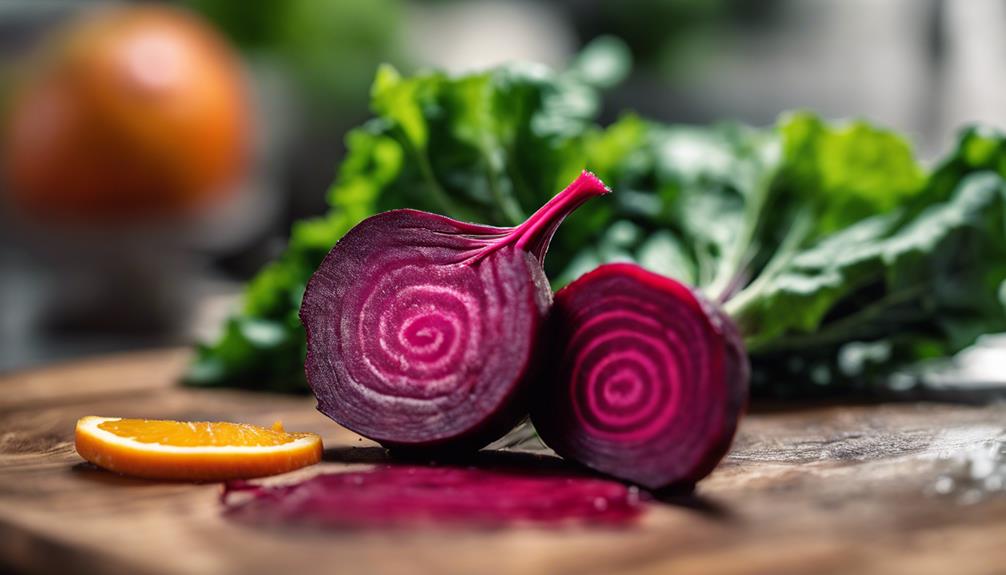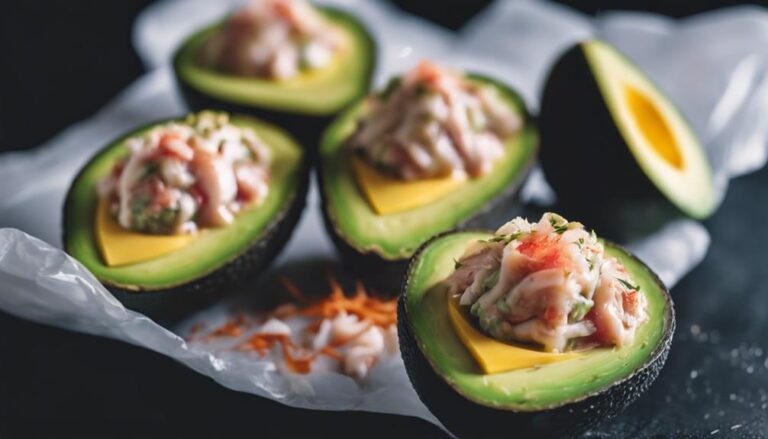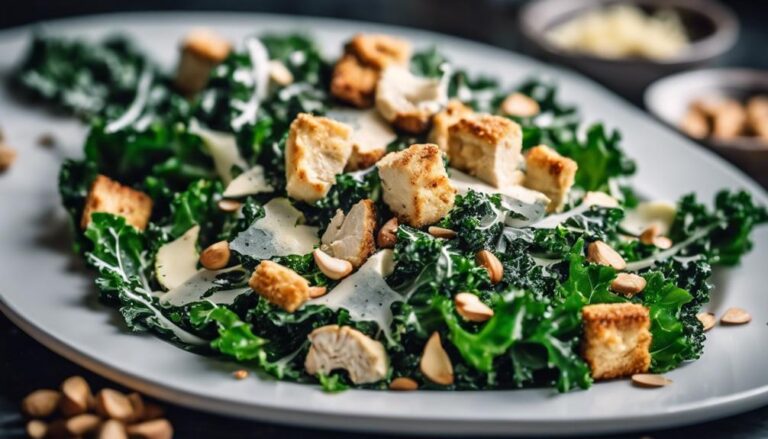Sous Vide Roasted Beet and Orange Salad
Indulge in the vibrant fusion of flavors and textures with our Sous Vide Roasted Beet and Orange Salad. Immerse beets in tantalizing seasonings, roast them to perfection, and pair them with zesty citrus for a culinary masterpiece. The sous vide method maintains the beets' natural sweetness, creating a tender and flavorful experience. Slicing the beets adds a delightful presentation touch, while the balsamic citrus dressing brings out their earthy essence. With each bite, savor a symphony of tastes that harmonize in a burst of deliciousness. Get ready to elevate your dining journey with this unique salad creation!
What You Will Learn Here
- Sous vide cook beets at 185°F for 2 hours to preserve sweetness.
- Ice bath cooling maintains ideal texture for the salad.
- Slicing beets enhances presentation and dressing absorption.
- Balsamic citrus dressing with orange and lemon juice complements earthy beets.
- Salad offers a blend of flavors and textures for a delightful culinary experience.
Beet's Evolutionary Journey

Imagine the humble beet, originating from its wild relative, the sea beet, thriving along the Mediterranean shores.
Over time, ancient civilizations like the Romans recognized its potential, harnessing both its roots and leaves for sustenance and healing.
Through meticulous cultivation, beets have evolved into a diverse array of varieties, reflecting centuries of human influence and innovation.
Beet's Origins
In tracing the evolutionary journey of beets, one uncovers a fascinating narrative of adaptation and cultivation that spans ancient civilizations to modern culinary delights. Beets, scientifically known as Beta vulgaris, have a rich history dating back to ancient times when they were first cultivated in the Mediterranean region. Initially grown for their leaves, the cultivation of beets has evolved over centuries through selective breeding, resulting in the diverse varieties we enjoy today, such as red, golden, and striped beets. These roots have not only become a staple in various cuisines but have also been used for medicinal purposes. The wide range of beet varieties available showcases their adaptability to different climates and growing conditions.
| Beet's Origins | Key Points |
|---|---|
| Ancient cultivation in the Mediterranean region | Grown for leaves initially |
| Evolution through selective breeding | Development of red, golden, and striped varieties |
| Culinary and medicinal uses | Popular vegetable in various cuisines |
| Adaptability to different climates | Diverse range of beet varieties |
| Reflection of evolution and cultivation | Modern culinary delights |
Adaptation to Environments
Beets, with their remarkable ability to flourish in a wide range of environments, showcase a remarkable evolutionary journey marked by adaptability and resilience. Originating from the Sea Beet along coastlines in Europe, Asia, and North Africa, beets have evolved to thrive in diverse conditions, from temperate regions to subtropical climates. Through centuries of selective breeding, they've been cultivated for their roots, leaves, and seeds in various agricultural settings.
Beets have undergone genetic studies revealing complex evolutionary histories, including hybridization events with other Beta species. Their adaptations, such as storage root development and tolerance to different soil conditions, contribute to their success in varied habitats. When roasted with olive oil in a water bath, beets reveal not just their culinary versatility but also their incredible adaptation to environments.
Evolutionary Survival Traits
Having adapted to a myriad of environments, beets' evolutionary journey reveals a story of resilience and survival marked by remarkable traits.
The striking red color of beets, a result of betalains, isn't just visually appealing but also an evolutionary trait that aids in attracting pollinators essential for reproduction. This vibrant hue serves as a beacon in nature's tapestry, showcasing the plant's ability to guarantee and thrive.
Moreover, beets' high sugar content is an evolutionary strategy that guarantees efficient energy storage, allowing the plant to endure harsh conditions. Their taproot structure, anchoring securely in the soil, highlights their ability to absorb nutrients effectively, supporting growth and development.
Over centuries, beets have been honed through selective breeding, demonstrating their adaptable nature in human agriculture.
Beet's Colorful Ingredient Varieties

With a spectrum of hues ranging from deep reds to vibrant golds and whimsical candy cane stripes, beet varieties offer a colorful and flavorful array to elevate your salads. Each type brings its unique characteristics to the table, making beet salads not only delicious but visually appealing as well.
- Red Beets: Common and versatile, red beets add a rich earthy flavor to salads when cooked sous vide. They're perfect for absorbing the flavors of olive oil and other dressings.
- Golden Beets: With a milder flavor profile compared to their red counterparts, golden beets bring a subtle sweetness that complements other ingredients in a beet salad beautifully.
- Candy Cane Beets: These playful beets feature striking red and white stripes, adding a fun and festive element to your dishes. Their peppery undertones provide a unique twist to the flavor profile.
- Mix and Match: Combining different beet colors in a salad creates a vibrant and eye-catching presentation that's sure to impress both visually and gastronomically.
- Flavorful Variety: Beet varieties offer a range of flavors, from earthy and sweet to slightly peppery, allowing you to experiment and find your favorite combinations.
Tasty Beet Salad Variations
Looking to elevate your beet salad game?
Consider trying out variations like the classic Beet and Feta Salad for a creamy and tangy twist.
Or explore the invigorating combination of Beet and Pomegranate Salad.
If you're a fan of texture, the Beet and Walnut Salad might be just what you need with its crunchy and earthy elements.
Beet and Feta Salad
When crafting a delicious beet and feta salad, consider the classic combination of earthy beets and tangy feta cheese for a delightful mix of flavors and textures. The sweetness of beets pairs perfectly with the salty and creamy feta cheese. Adding fresh herbs like mint or parsley can enhance the flavors of the beet and feta salad. A simple vinaigrette dressing with olive oil, lemon juice, and herbs can tie the ingredients together in the salad. The vibrant colors of beets and feta cheese make this salad visually appealing and appetizing.
- Earthy beets and tangy feta cheese create a delightful mix.
- Sweetness of beets complements the salty and creamy feta.
- Fresh herbs like mint or parsley can enhance the flavors.
- Simple vinaigrette dressing with olive oil, lemon juice, and herbs ties the ingredients together.
- Vibrant colors of beets and feta cheese make the salad visually appealing.
Beet and Pomegranate Salad
For a delightful twist on traditional beet salads, consider exploring the vibrant and flavorful combination of sweet and tangy ingredients in a Beet and Pomegranate Salad. This salad typically features sous vide beets, fresh pomegranate seeds, and a citrusy dressing that combines the zing of orange juice.
Here are some key points about this tasty variation:
- The addition of pomegranate seeds adds a juicy crunch and a pop of color to the salad.
- Beet and pomegranate salad is rich in antioxidants, vitamins, and minerals, making it a nutritious choice.
- The blend of earthy beets and sweet pomegranate creates a well-balanced and visually appealing dish.
- To enhance the flavor profile, crumbled goat cheese can be sprinkled on top.
- The sweet and tangy elements in this salad create an invigorating and satisfying eating experience.
Beet and Walnut Salad
Indulge in the delightful combination of earthy beets and crunchy walnuts with a vibrant Beet and Walnut Salad. When preparing this tasty dish, consider these tips:
- Roast Beets in a Sous Vide Bag: Lock in the flavors by cooking the beets sous vide style for a tender texture.
- Toast Walnuts: Enhance the nuttiness of the walnuts by toasting them before adding them to the salad.
- Drizzle with Olive Oil and Season: Finish off your salad with a drizzle of quality olive oil and a sprinkle of your favorite seasoning for an extra burst of flavor.
- Add Cheese: Elevate the creaminess and tanginess by incorporating goat cheese or blue cheese into the mix.
- Herbaceous Touch: Brighten up the salad with fresh herbs like parsley or dill for a invigorating finish.
Beet Preparation Techniques
When preparing beets for sous vide cooking, start by trimming the roots, washing, peeling, and vacuum sealing them with your choice of seasonings.
Cooking the beets at 185°F for 2 hours guarantees they come out tender and packed with flavor.
After the sous vide process, cooling the beets in an ice bath helps them maintain their texture and vibrant color for a visually appealing salad presentation.
Beet Roasting Methods
To achieve perfectly roasted beets, make certain that your oven is preheated to 375°F and remember to scrub the beets clean while leaving the 1-inch stems intact.
Once prepped, tightly cover the beets with foil in a glass baking dish and roast them in the oven for approximately 45 minutes until they're tender.
After roasting, allow the beets to cool before peeling them. The skin should easily slide off, revealing the beautifully cooked flesh underneath.
Once peeled, you can slice the roasted beets into rounds or wedges, ready to be incorporated into your vibrant salad.
This method guarantees that the beets are cooked to perfection, bringing out their natural sweetness and earthy flavors.
Citrus Infusion Techniques
After perfectly roasting your beets, the next step to elevate their flavor profile is through citrus infusion techniques using orange juice, lemon juice, or vinegar. Citrus-infused beets offer brightness and acidity that enhance their natural earthy sweetness. This infusion method is ideal for sous vide cooking as it allows the flavors to penetrate deeply into the beets. Below is a table showcasing different citrus infusion techniques for beets:
| Technique | Description |
|---|---|
| Marinating | Soaking beets in citrus juices for added flavor. |
| Cooking Liquid | Adding citrus juices or vinegar to the cooking liquid. |
| Dressing | Using citrus-based dressings for salads or dishes. |
Incorporating citrus into your beet preparation not only adds a invigorating twist but also balances the overall taste, making it a versatile ingredient in various recipes.
Dressing Flavor Combinations
For a vibrant and flavorful beet salad, consider experimenting with unique dressing flavor combinations like citrus vinaigrette, honey mustard, or herb-infused olive oil. Enhance the dressing by incorporating ingredients such as Dijon mustard, shallots, garlic, or fresh herbs to elevate the flavor profile of the salad.
To balance the flavors, add a touch of sweetness with honey, maple syrup, or agave nectar, complementing the earthy beets and citrusy oranges. For an added depth of flavor, consider incorporating acidity with lemon juice, apple cider vinegar, or balsamic vinegar.
Customize the dressing to your liking by adjusting the seasoning, acidity, sweetness, and herb profiles, creating a harmonious blend of flavors that suits your taste preferences perfectly.
Final Thoughts
In reflecting on this Sous Vide Roasted Beet and Orange Salad journey, consider the harmonious blend of flavors and textures that culminate in each delightful bite.
The sous vide method guarantees that the beets are cooked to perfection at 185°F for 2 hours, resulting in a tender yet still slightly firm texture that preserves their natural sweetness. Cooling them in an ice bath afterward helps maintain this ideal consistency.
Slicing the beets into bite-size pieces not only enhances the salad's presentation but also allows for a more even distribution of the white balsamic vinegar dressing, which adds a delicate tanginess to every mouthful.
The addition of a balsamic citrus dressing with orange juice, lemon juice, and vinegar brings a revitalizing and zesty flavor that complements the earthiness of the beets.
Frequently Asked Questions
How Long Does It Take to Sous Vide Beets?
When you sous vide beets, the cooking time at the ideal temperature of 185°F depends on your texture preference. Typically, it takes about 2.5 hours for tender beets. Adjust it to your liking.
Can You Freeze Sous Vide Beets?
You shouldn't freeze sous vide beets; they're best enjoyed fresh. Freezing alters their texture and taste, making them mushy and less flavorful. To preserve their sous vide benefits, avoid freezing. Instead, consider other storage options for best results.
How Do I Prepare Beets?
To prepare beets, start by roasting them in the oven at 375°F after scrubbing them clean and cutting off the greens. Once cooked, peel and slice the beets for various recipes, like salads, or enjoy them seasoned with herbs and olive oil.
How Do You Add Flavor to Cooked Beets?
To add flavor to cooked beets, try mixing in zesty citrus juice or balsamic vinegar for an acidic punch. Experiment with seasoning techniques like honey or maple syrup to enhance sweetness. Roast, boil, or grill beets for different textures.
Conclusion
Indulge in the vibrant flavors of sous vide roasted beet and orange salad, a dish that celebrates the rich history and versatility of beets.
With a rainbow of colorful varieties and endless tasty variations, this salad is sure to impress your taste buds.
By mastering beet preparation techniques, you can elevate your culinary skills and create a stunning dish that's both delicious and visually appealing.
So go ahead, get cooking and enjoy the delicious journey of beet exploration!











